[ad_1]
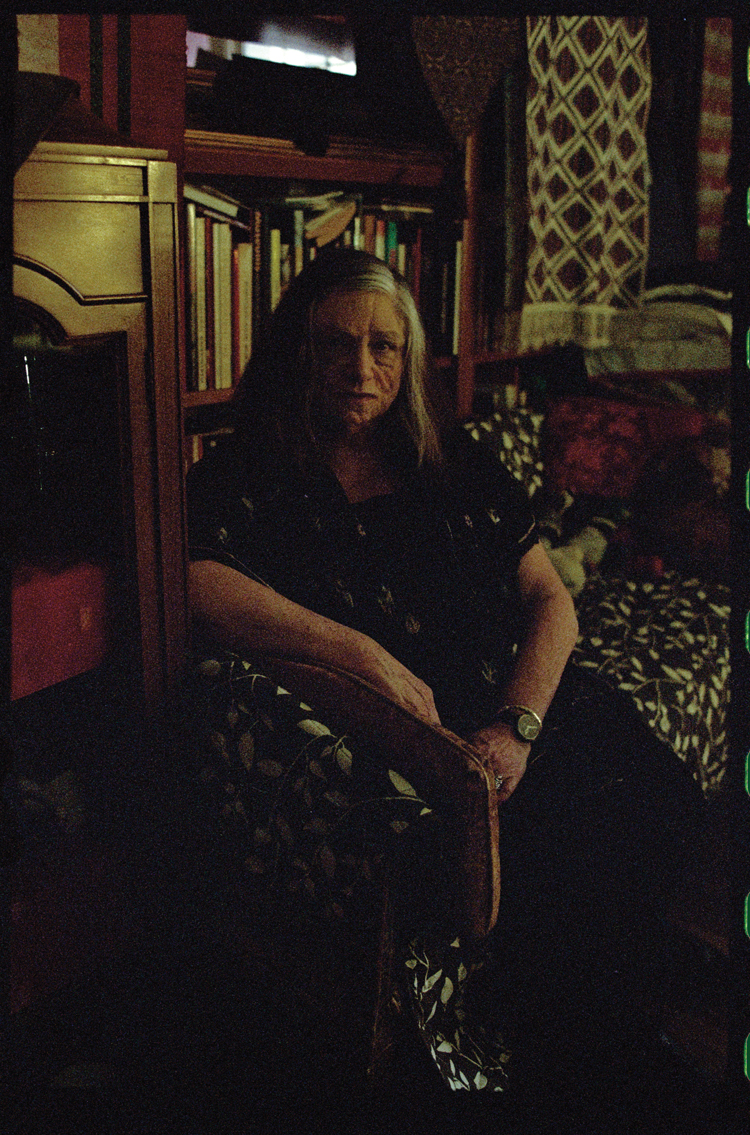
Dara Birnbaum.
EMMA TILLMAN
[Read all five “Icons” profiles from ARTnews’s Spring 2018 issue, featuring Dara Birnbaum, Arthur Jafa, Amalia Mesa-Bains, Fred Moten, and Cady Noland.]
In 1970 Dara Birnbaum and a group of anti-war demonstrators in San Francisco stared down a television set that had been placed on a podium as if it were an authority figure poised to address an audience. The set was broadcasting news about the Cambodian Civil War. Dismayed by American involvement in the conflict, a demonstrator shouted at the TV, “Are we going to take that?” Birnbaum and others shouted back, “No!” The demonstrator then took a mallet and smashed the screen. “When that TV exploded, as if one could stop the war that way,” Birnbaum recalled recently, “I thought, I’m going out and buying a TV—I want to see what the people in America are watching.”
In the years following the acquisition of her first TV set, Birnbaum went on to create an important body of work about the media and its hidden political values. Since the 1970s, her pioneering videos and multimedia installations have analyzed and questioned the concepts, ideas, and mechanisms at work in mass media, in particular television. Among her masterworks is a 1978–79 video piece now regarded as an art-historical milestone: Technology/Transformation: Wonder Woman. Using footage appropriated from the airwaves, Birnbaum looped, remixed, and reedited images from the TV program in which Lynda Carter played a secretary, who also happened to regularly transform herself into a superhero.
Birnbaum’s piece blows open that transformation’s artifice. In one of its most significant moments, the video fixes on the familiar image of the hapless secretary in her drab daytime garb twirling away and, after an explosive effect, reappearing in superhero gear: red knee-high boots; tight, high-cut starry shorts in blue; a red bustier adorned with an eagle; and a large gold headband. Birnbaum repeated the scene seven times over; as the image stutters, it forces the viewer to look closer and consider the change taking place. The video concludes with karaoke-style scrolling lyrics from the song “Shake Thy Wondermaker!” by the Wonderland Disco Band, flush with orgasmic ahh-hh-hhs and ohh-hh-hhs.
For some women at the time, Wonder Woman was an inspiring figure, a metaphor for feminist might. But for Birnbaum, the character was an embodiment of the same kind of disempowering images she had been seeing on television for years. “I wouldn’t call that liberation,” she told me. “How dare you confront me with this supposedly super-powered image of a woman who is stronger than I am and can also save mankind? I can’t do that, and I won’t—and there’s no middle ground in between. The middle ground is what we need to work from.”
Birnbaum, who is now 71, has been regarded as part of the Pictures Generation, a group of New York artists who, during the ’70s and ’80s, lifted images from mass media to ponder a mediated world. She has been talked about in relation to feminist art and the early generations of video art as well. But it is only recently that Birnbaum’s prescient vision has come in for proper consideration. After a 2009 retrospective in Europe failed to find a home in America, in the past year her work has appeared in major museum shows at the Met Breuer, the Institute of Contemporary Art, Boston, and the Hirshhorn Museum and Sculpture Garden in Washington, D.C. The present era’s interests—image circulation, media consumption, and identity politics—have aligned with concerns that captivated Birnbaum from the beginning of her career.
“The whole idea of appropriating material from popular television and then remixing, reediting, and reworking it to expose its meaning is something she is directly responsible for,” said Lori Zippay, executive director of Electronic Arts Intermix, an organization in New York that has advocated for video art since 1971. “[Her work] profoundly affected the way we view images and culture.”
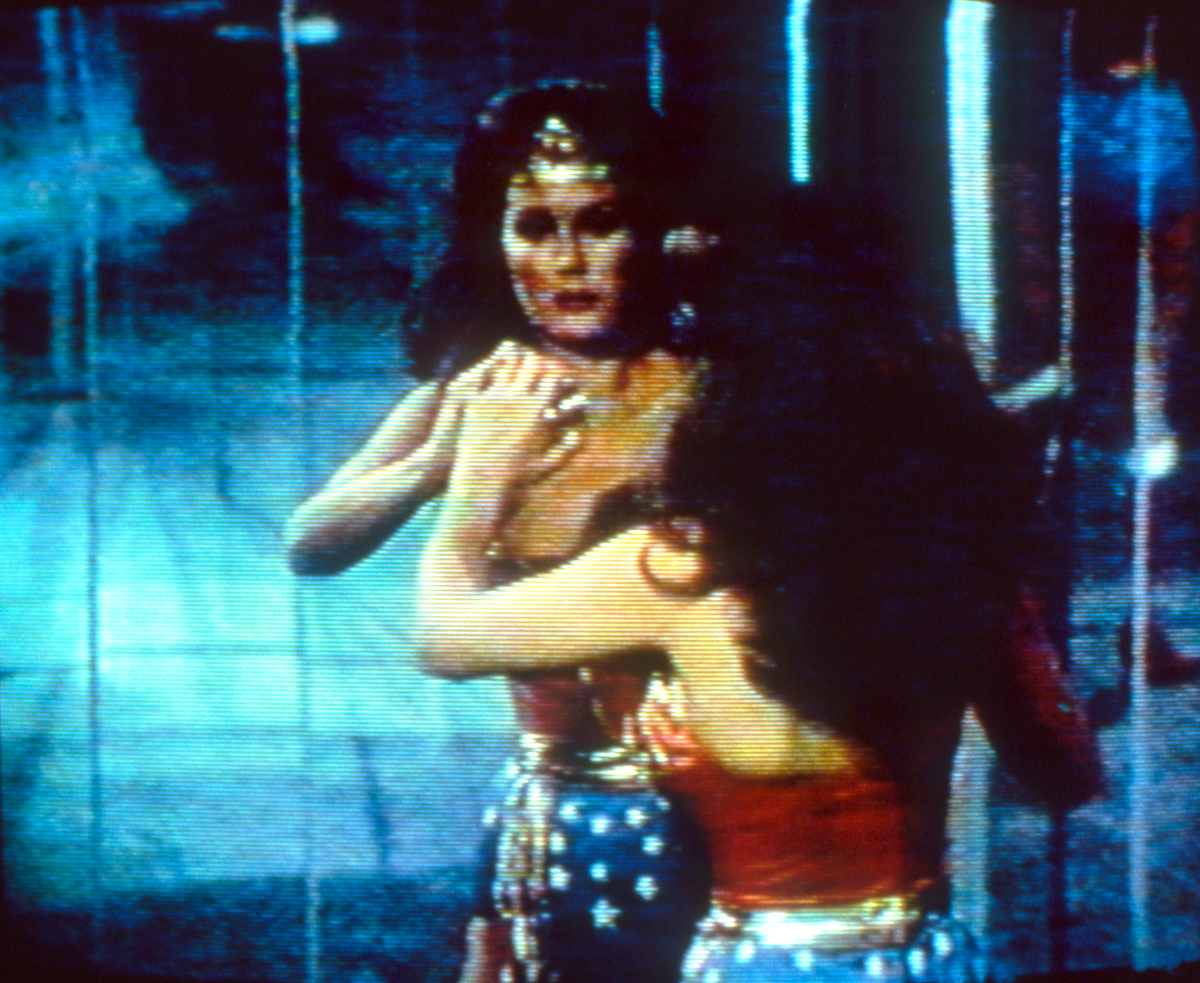
Dara Birnbaum, Technology/Transformation: Wonder Woman, 1978–79.
©DARA BIRNBAUM/COURTESY MARIAN GOODMAN GALLERY, NEW YORK
‘There is such a flood of imagery that producing meaningful images now is like producing meaningful news in an era where you have a president saying everything is fake,” Birnbaum told me with a note of resignation on a recent afternoon. We were seated at a table in her apartment in SoHo, where she has lived and worked since 1980. Instead of artistic tools one might expect to see in a traditional studio, her residence was filled with books, sheet music, and holiday cards. She regularly watches the news on TV at home, she said. (And Law & Order. “I have a passion,” she said. “I don’t understand why.”) Much of her hands-on work is completed elsewhere, with the help of editors, technicians, and musicians, and Birnbaum’s only assistants that day were her dog, Tama, and a bird named Linear, who squawked at the artist until being forcefully told, “That’s enough!” A cat named Chaz slept in an adjacent room; a Bach string concerto swelled from a radio.
Birnbaum is a rigorous researcher, with an impressive library to consult. But though academics often name-check all sorts of theory in regard to her work—Lacanian psychology, structuralist film theory, poststructuralist philosophy—she said she has always considered herself more of an intuitive artist. She is fond of the experimental playwright Bertolt Brecht’s idea that “one can start to look for holes” in media. Her career began as a quest to find such holes.
Birnbaum was born in 1946 in the Forest Hills neighborhood of Queens, New York. Her father was an architect, and her mother, a scientist who later became a housewife. As a teenager, she was “knocked out” by the work of postwar American artists including Larry Poons, Jules Olitski, Andy Warhol, and Robert Rauschenberg. She went on to study architecture at Carnegie Mellon University, where she was the youngest woman to enter the program. “Never again,” she recalls the school’s chauvinist dean saying as he handed over her degree at graduation.
After moving to San Francisco, Birnbaum took a job at the highly regarded architecture firm Lawrence Halprin & Associates, which had an interest in community needs. “That was great, but architectural planning always seemed to come down to economics and politics. I started drifting toward the arts.” In 1974 she moved with an Italian architect she had met to Florence, Italy, where she first came into contact with video-art technology. At the time, the equipment used to make and edit videotapes was expensive and largely inaccessible, so a gallerist, Maria Gloria Bicocchi, had started Art/Tapes/22, a studio that enabled many of the most important early video artists to create work in Florence. It was there that Birnbaum met visiting artists like Vito Acconci, Charlemagne Palestine, Dickie Landry, and others whose work deeply affected her. “Everyone was saying, ‘Come back to New York—it’s very dynamic,’ ” Birnbaum recalled of her stint in Italy. “So that’s what I did.”
When she arrived in Manhattan, she took cues from Minimalist and Post-Minimalist filmmaking and made a body of work that moved some of her male colleagues’ concerns in a feminist direction. For a series known as “Chaired Anxieties,” she filmed herself sitting on a chair while writhing around, throwing herself down, and collapsing in what appears to be a state of extreme fatigue. “That’s an Acconci influence,” she said, “but it’s saying: what is it like if a woman takes that centralized position?”
Another early work, Attack Piece, from 1975, pits photographs of men filming Birnbaum against footage of Birnbaum taking pictures herself. “She is the subject of this visual attack, but she’s also retaliating and wresting her image away from her attackers,” said Henriette Huldisch, who included the work in the exhibition “Before Projection: Video Sculpture 1974–1995,” currently running at the MIT List Visual Arts Center in Cambridge, Massachusetts. “As the viewer, you’re in the middle of this visual attack field, which is gendered.”
At the same time she was making these pieces Birnbaum was immersing herself in film theory. She had already become fascinated by the French New Wave director Jean-Luc Godard and his partner, Anne-Marie Miéville, who had by then pioneered a Marxist style of media analysis that involved scrutinizing images native to pop culture. The French collaborators, Birnbaum said, made it so that “sound and image were equally weighted,” a distinction that she and her friends, in particular, artist Dan Graham, would integrate into their work.
But Birnbaum came to recognize something missing from all the analysis that surrounded cinema in magazines and journals at the time. “After saving money to buy Screen and October by waitressing, I’d read these positions and say, ‘My gosh, they’re not talking at all about television!’ ” And so it was that her interest in a different medium took hold, she said, “as a kind of rebellion.”
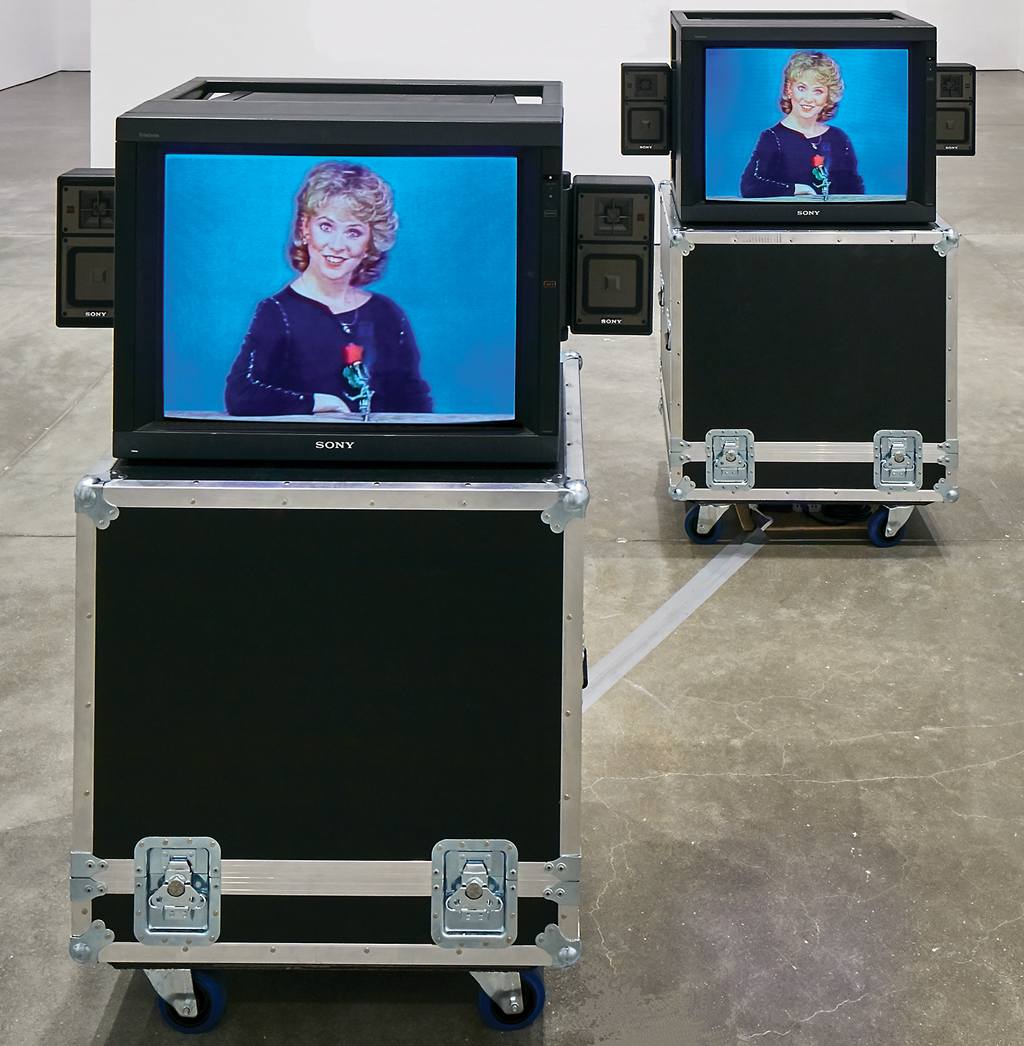
Dara Birnbaum, Kiss the Girls, Make Them Cry, 1979.
©DARA BIRNBAUM/COURTESY MARIAN GOODMAN GALLERY, NEW YORK
Using television in art wasn’t exactly new when Birnbaum adopted it as a medium. The artist Nam June Paik had been making art from TVs since the early 1960s. In 1963 he began working with found footage and using magnets to disrupt ambient broadcasts. His work, which addressed the growing ubiquity of TV, presaged the following decade, when the average American watched more than seven hours of television a day, according to Nielsen Media Research.
For Birnbaum, TV “was a determinant of social space,” not unlike architecture. She began photographing TV screens broadcasting crime dramas, but was eager to get her hands on actual footage. “There was no direct access to television, and that meant a lot to me,” she said. “How do you take hold of the seemingly seamless flow of television, which is inaccessible? How do you get hold of it?”
She came to rely on friends who worked at TV networks and also learned to pirate material herself. Her first work to feature exclusively appropriated material was (A)Drift of Politics: Two Women Are Active in a Space (1978), a multiroom installation that deconstructed footage from the sitcom Laverne & Shirley. In one room was a TV playing the show without sound, but with added subtitles, as well as a film projection featuring the same footage sans any text; in an adjacent room, the soundtrack played.
Birnbaum’s formula—take a TV show, analyze it, remix it—did not much interest the art market at the time. “The galleries, from the beginning, I felt they didn’t want us,” she said. Some of her most iconic works, among them Technology/Transformation: Wonder Woman, showed in alternative spaces such as the Kitchen, nightlife haunts like Danceteria and the Mudd Club, and, in one instance, the storefront of a SoHo hair salon. They also showed sometimes on television itself, as happened when her video work aired on cable TV alongside an airing of an episode of Wonder Woman. (She conceived three other videos based on The Incredible Hulk, The Bionic Woman, and The Six Million Dollar Man, but they never came to fruition.)
As she kept watching, Birnbaum found more to mine from TV, combining footage recorded from the game show The Hollywood Squares with disco music to create the 1979 installation Kiss the Girls: Make Them Cry. For her “Pop-Pop Video” series, she mashed together a shootout from the crime drama Kojak with a commercial for Wang Laboratories computers to make Kojak/Wang (1980). At that time, such work required patience and skill. “The process was exasperating,” she said of procedures that included manually punching buttons and working with tape. “Once, while trying to do loops of Wonder Woman turning and twisting, I almost put my hand through the wall of the edit room.”
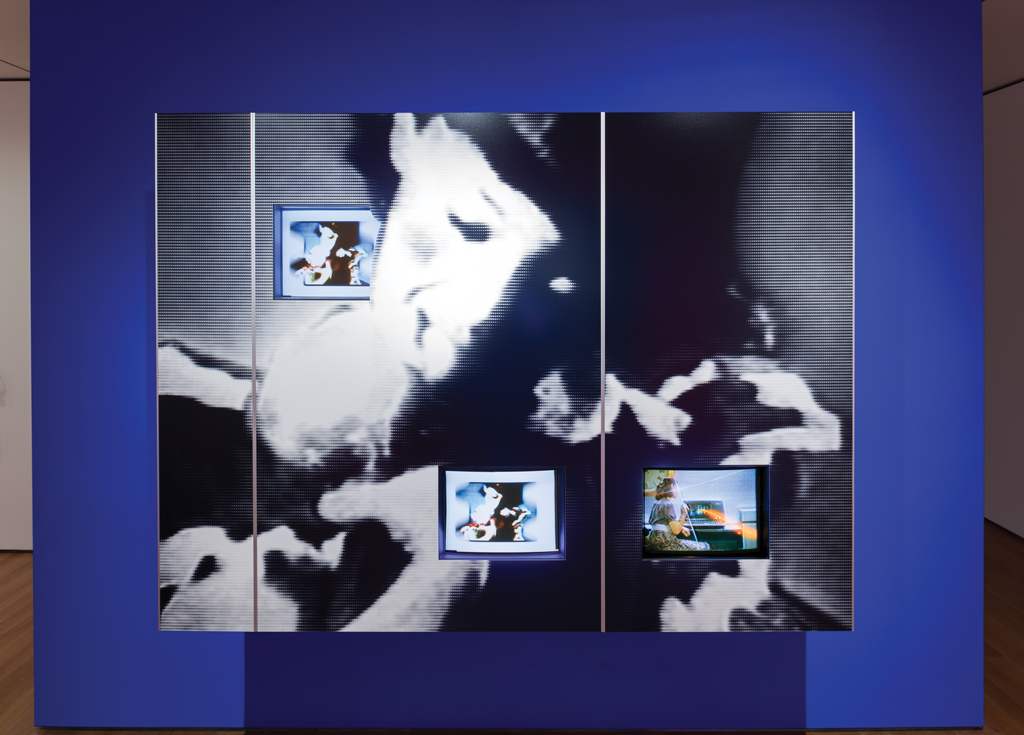
Dara Birnbaum, PM Magazine (still), 1982, on view at the Museum of Modern Art.
©DARA BIRNBAUM/COURTESY MARIAN GOODMAN GALLERY, NEW YORK
As she continued to toil, the art world began to take notice. In 1982 she conceived a work, PM Magazine, that—aside from a piece by Joan Jonas that employed just one screen—counted as the only video piece in curator Rudi Fuchs’s painting-heavy 1982 edition of Documenta in Kassel, Germany. PM Magazine is an elaborate five-channel installation that shares its name with a late ’70s to late ’80s TV show with a news and entertainment format, giving each equal time. Using footage from the program’s opening sequence, Birnbaum rhythmically mixed it to present the image of an office worker smiling in a commercial with a soundtrack that was a recomposed version of the song “L.A. Woman” by the Doors. One wall in the installation was colored Chroma Key Blue, an alternative to today’s green-screen backgrounds that was easily altered with digital special-effects technology.
By utilizing aspects of moving-image production that were shared mainly among editors and technicians, Birnbaum was “using the historical language of color and paint to create a space for technology,” said Stuart Comer, chief curator in the Museum of Modern Art’s media and performance art department. In doing so, she elevated video beyond a format that “had been relegated to secondary spaces,” Comer added.
In the mid-’80s, the art world changed its attitude toward appropriation. In a 1982 essay in Artforum, Benjamin Buchloh wrote about ways that Birnbaum, Martha Rosler, and other artists of their ilk made art that worked as weaponry against consumer culture but also, he believed, ran the risk of becoming part of that culture as well. They had been “successful in their assault,” Buchloh wrote, “if only temporarily so.” And, indeed, Birnbaum pushed to move her work into mainstream media, even working in 1987 on commission for MTV. (This was around the time Andy Warhol had his own MTV show, Fifteen Minutes.) Interested in certain similarities between her work and music videos, the network asked Birnbaum to create an “art break,” a 30-second spot to air during a commercial break. Birnbaum recalled that, when MTV approached her, Buchloh asked, “Are you crazy? Why are you entering a supermarket of imagery? Isn’t that like entering the enemy’s domain?” She forged ahead anyway, creating a work that involved the MTV logo, a Max Fleischer cartoon, and blurred images of a female animator all in a matter of 30 seconds. It showed at the time on airwaves shared with antic music videos by the likes of U2, Whitney Houston, Madonna, and Bon Jovi.
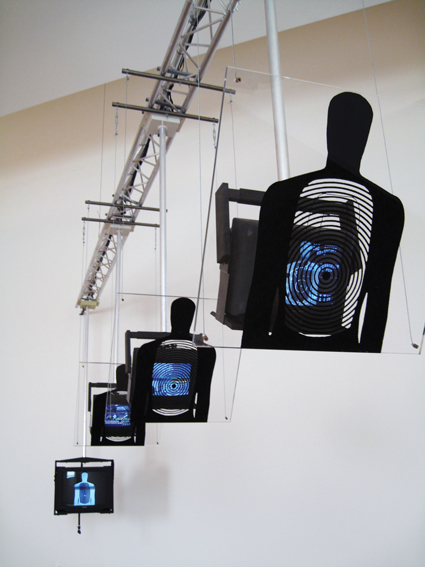
Dara Birnbaum, Hostage, 1994/2010.
©DARA BIRNBAUM/COURTESY MARIAN GOODMAN GALLERY, NEW YORK
A few years prior to her work with MTV, Birnbaum set aside her interest in found material to shoot footage of her own. “I wanted to use digital technology when it first came out, and I thought it could be used in better ways than what TV was then using it for,” she said. “I wanted to see what it felt like to make one’s own images.”
Between 1983 and 1987, she produced a trilogy called Damnation of Faust, which retells the Faust legend in modern-day New York. Rather than relating the story directly, she created a narrative involving the destruction of a playground in Manhattan, and informed by techniques usually reserved for music videos and advertising—wipes, fades, superimpositions, cutouts. Her interest in such forms stemmed in part from centuries-old Japanese prints that made use of a “multiplicity of frameworks, frames within frames,” she said. “Formally, that’s what I took my inspiration from.”
As for her turn toward storytelling, it proved a precursor to the more essayistic work she would develop in the decades to come, while retaining a focus on TV’s incursions into daily life. In galleries and museums, Birnbaum zeroed in on the ways that news programs impact collective views of political events. “Media claims to provide you with ‘eyewitness news,’ ” she said. “This is a pretense. We are exposed only to edited news created by television stations and their conglomerates.”
In a 1990 installation titled Tiananmen Square: Break-In Transmission, Birnbaum compiled different broadcasts related to the student-led 1989 protests in Beijing and showed them on five monitors arranged so that they couldn’t all be seen at once. Then, in 1994, she staged Hostage, a technically elaborate work about Hanns-Martin Schleyer, a German industrialist who was kidnapped in 1977 by leftist militants and forced to go on TV to declare himself an enemy of the state—after which spectacle he was killed. Original uncensored footage of his speech was hard to find, so Birnbaum called on her contacts at TV networks across Europe to find what she called “potent imagery.” The resulting artwork includes footage of the speech in German, as well as American news broadcasts from the time, on monitors suspended from the ceiling amid Plexiglas targets. A laser runs through the installation, and when the viewer interrupts it, the images freeze. “If you align yourself with the images and the targets hanging down, you break the connection between the footage and the news being reported,” Birnbaum said.

Dara Birnbaum, Psalm 29(30) (still), 2016.
©DARA BIRNBAUM/COURTESY MARIAN GOODMAN GALLERY, NEW YORK
In recent years, Birnbaum has continued exploring media’s pervasiveness in every aspect of contemporary life. For her 2016 installation, Psalm 29(30), she ventured into the covert depths of the dark web to find footage of conflict in the Middle East. She played violent videos in a secluded space within a room on whose walls screens showed decidedly different footage of serene Italian landscapes. “Everything now has become a proliferation of image and sound, and even speech is not to be trusted,” she said. “But Psalm 29(30) is asking for a moment of quietude and contemplation of what is more eternal.”
“It’s interesting to look at contemporary art through Dara’s lens,” said Jessie Washburne-Harris, senior director at Marian Goodman Gallery, which has represented Birnbaum since 2002. “She’s incredibly prescient, if you think about all the artists of the so-called post-internet generation.” In the same way that Birnbaum mined material from TV, younger artists like Mark Leckey, Martine Syms, Jon Rafman, Sondra Perry, and Camille Henrot have lifted imagery from the internet and edited it together in dense, fast-paced assemblages reminiscent of Birnbaum works like Technology/Transformation: Wonder Woman.
In a testament to her influence on contemporary colleagues and peers, Birnbaum features in “Art in the Age of the Internet, 1989 to Today,” an exhibition on view through May at the Institute of Contemporary Art, Boston, among work by Hito Steyerl, Seth Price, and Aleksandra Domanović, all of whom are generations younger. Deriving from an unrealized project from the ’90s, Birnbaum’s Computer Assisted Drawings: Proposal for Sony Corporation (1992–93) comprises software-generated renderings of 3-D space that she cast on plastic and reimagined as vivid wall works that stay still while also seeming to squirm beyond their frames.
“She was interested in taking found images, whether still or moving, and processing them in a way that is singular,” said Eva Respini, who co-curated “Art in the Age of the Internet.” “This editing, this stuttering, this way in which [she] borrows from all realms high and low—if we think back, it was radical.”
That radicality remains. “Her use of video and found footage, her editing and image processing, are groundbreaking,” Respini added. “It’s what kids do now on YouTube. This is our visual language.”
A previous version misstated details about Birnbaum’s work. The Damnation of Faust works were completed in 1987, not 1984. Technology/Transformation: Wonder Woman was aired alongside a broadcast of Wonder Woman, not during it. The version of the song used in the video is titled “Shake Thy Wondermaker!,” not “Wonder Woman Disco.” Additionally, Birnbaum moved to Florence in 1974, not 1975.
A version of this story originally appeared in the Spring 2018 issue of ARTnews on page 64 under the title “Changing Channels.”
[ad_2]
Source link

